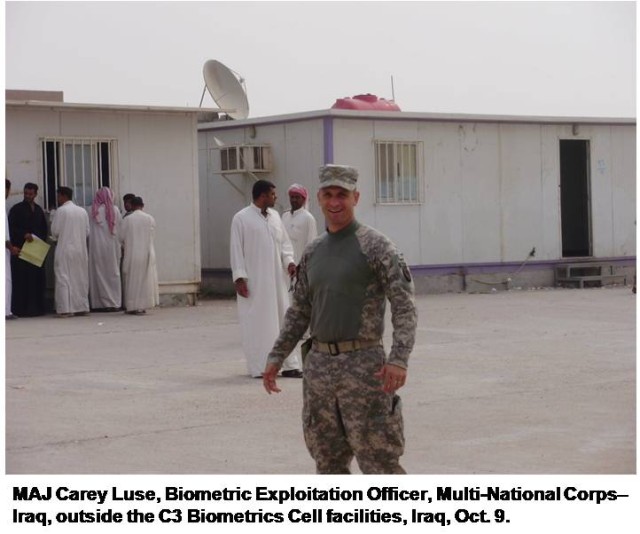FORT HUACHUCA, Ariz. - After nearly 20 years of service to the Army, Maj. Carey Luse left Fort Huachuca, Ariz., for Iraq in August 2009 to be part of the Multi-National Corps - Iraq, Command, Control, and Computers (C3) Biometrics Cell. With this tasking, Maj. Luse's job focus takes on a dramatic shift.
His duties in Iraq include creating and enforcing Coalition Forces policy related to data including fingerprints, iris scans, and other forms of biometric identification. Maj. Luse also plays a key role in assisting the Iraqis with developing their own biometric capabilities both at the borders and throughout the country.
According to the U.S. Army's Biometrics Task Force, biometric capabilities enabled U.S. troops to catch more than 400 "high-value individuals" in Iraq and Afghanistan in 2008. Deputy Director Lisa Swan of the Task Force stated, "We've been very successful at catching bad guys."
After several years of compiling vast biometric databases that now contain identification information on more than 2.5 million Iraqis, the U.S. military is committed to the technology. Fingerprints and irises are screened against prints or irises of wanted individuals before Iraqis are allowed past checkpoints or into other facilities.
Biometric identifications are also required before local national employees are allowed to enter U.S. bases. And "we take biometrics on all detainees to see if they may be involved with other crimes," Swan said.
Detainees' fingerprints and iris scans are checked against databases that contain the biometric identities of individuals potentially linking them to specific crimes. There have been numerous matches.
Biometric screenings have also identified wanted individuals among the applicants for admission to the Iraqi Police Academy, the Biometrics Task Force reports. They have even turned up local nationals who have U.S. felony records.
Fingerprints lifted from crime scenes are added to the database in the hope that some day they will match with prints at the screening and biometric enrollment stations. U.S. troops have ordered Iraqi men, women, and children out of their villages and recorded their fingerprints and iris images before letting them return.
"It has proven to reduce violence," Swan said. "It keeps the bad guys out...the use of biometrics has clearly thwarted security breaches and helped prevent unwanted activities by the enemy," the Task Force asserts.
PRIVACY A PRIORITY
As U.S. forces prepare to turn more responsibility over to the government of Iraq, the biometric databases have begun to raise concerns over the privacy of the information.
As U.S. forces prepare to turn more responsibility over to the government of Iraq, there is some concern about how private the biometric databases will remain once they are no longer exclusively under U.S. military control.
"The biometric task force works diligently" to ensure that [a privacy violation] does not happen, a spokeswoman said. "Biometric data and associated biographic information is only shared with authorized users and partners," and it's "a top priority to ensure that such important personal information does not fall into the wrong hands," she said.
THE TOOLS
In Iraq and Afghanistan, the primary biometric collection and screening devices include the Biometrics Automated Toolset (BAT), Biometric Identification System for Access (BISA), and the Handheld Interagency Identity Detection Equipment (HIIDE).
The BAT is a four-piece kit that includes a rugged laptop, a separate digital camera for taking photos, a fingerprint reader, and an iris scanner. Photos, fingerprints, and iris scans are fed into the computer, where they can be compared against the previously stored biometrics of suspected insurgents, terrorists, and other wanted persons. The collected data eventually is transferred into a much larger "biometrics data repository."
The BISA is a biometric collection tool used on local and third-country nationals accessing U.S. bases in theater.
The biometric records are collected, screened, and stored in the biometric data base. Persons who clear the rigorous screening process will be issued a tamper proof, biometrically enabled "smart-card" for entry into our bases, typically for jobs that support of U.S. Forces.
The HIIDE is also used to mainly screen fingerprints, iris images, photos, and biographical data. It looks a bit like an oversized digital camera, but has enough memory to store 22,000 "full biometric and biographic portfolios," according to the manufacturer.
A portfolio includes two iris scans, 10 fingerprints, a photograph, and 35 items of biographic information. Troops use the collected biometric data to control access to bases, to screen job applicants, to restrict travel, and to aid in forensic investigations, according to the task force.. In addition, the task force has helped to develop other specialized biometric hardware as well.
Maj. Luse came to U.S. Army Information Systems Engineering Command (USAISEC) from the Naval Post Graduate School at Monterey, California. Upon his assignment to USAISEC, he was designated as a Project Lead for Enterprise Systems Engineering Command (ESED). At ESED, Luse was responsible for the management of project resources to include a multi-million dollar budget, seven Government engineering teams, and multiple contract teams.
Maj. Luse's future is still undetermined upon completion of his tour with C3 Biometrics. He hopes to remain a part of USAISEC, but is prepared to serve in whatever job heAca,!a,,cs needed.


Social Sharing